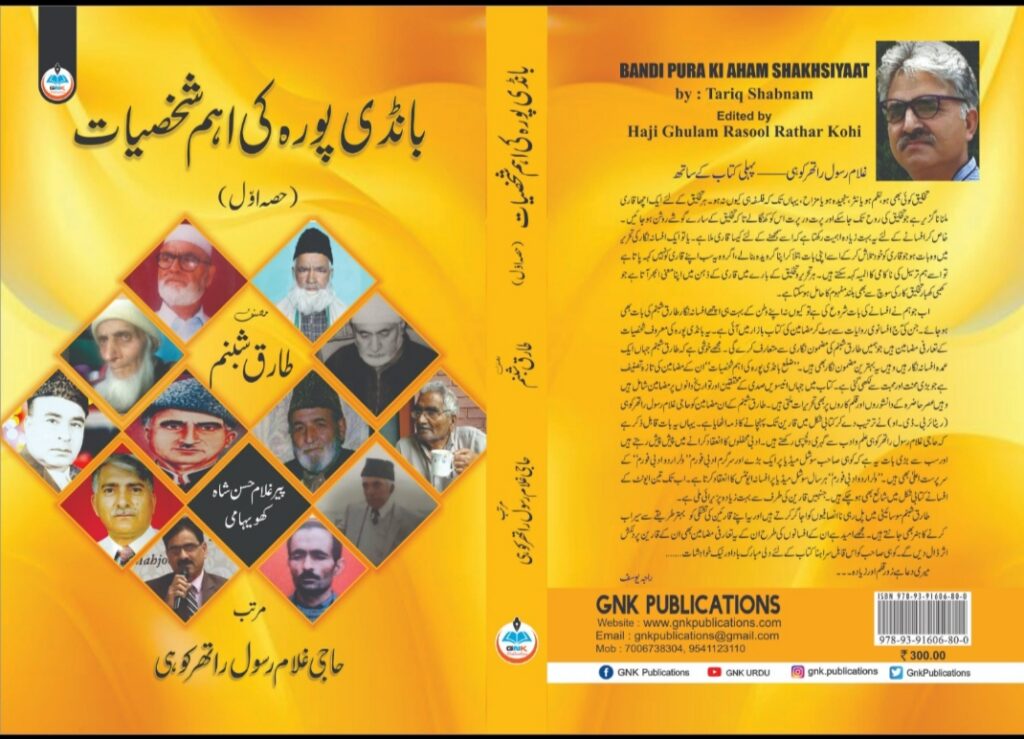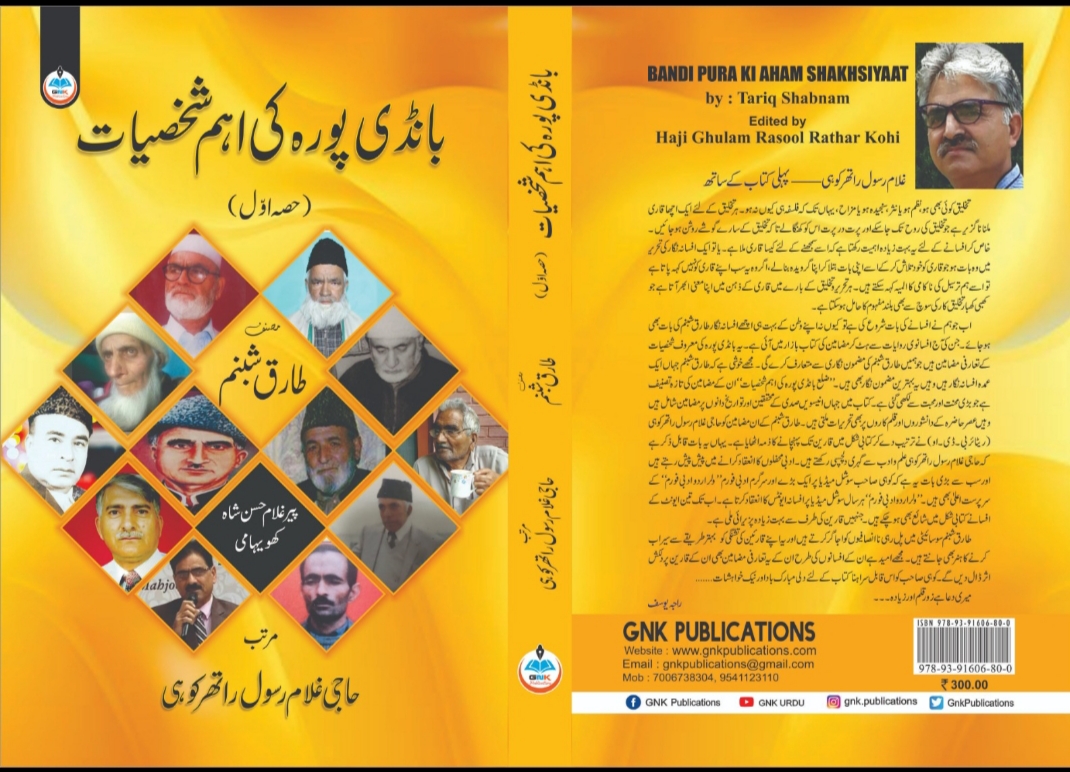By Rayees Ahmad Kumar
Nestled between the shimmering waters of Wular Lake and the snow-kissed peaks of North Kashmir, Bandipora has long been celebrated for three treasures — Ilm (Knowledge), Adab (Literature), and Aab (Water). This blessed land has nurtured a remarkable legacy, producing generations of poets, scholars, authors, educationists, and reformers who have left indelible marks on Kashmir’s intellectual and cultural history.
Among the district’s rising literary voices is Tariq Shabnam, a young but accomplished Urdu fiction writer from the village of Ajas. Known for his critically acclaimed short story collections, Shabnam has once again enriched the Valley’s literary shelf with his latest work, Bandipora Ki Aham Shakhsiyaat, published by the renowned GNK Publications. Spanning 91 pages, the book is compiled by Haji Ghulam Rasool Rather Kohi and features a striking cover adorned with portraits of Bandipora’s literary icons. The compilation brings to life the struggles, triumphs, and legacies of thirteen distinguished figures from the district.
Dedicated to his late parents, Shabnam’s work has drawn praise from literary stalwarts. Internationally acclaimed critic Dr. Riyaz Tawhidi describes it as “a treasure trove of knowledge” that rescues forgotten luminaries from the shadows of obscurity and places them before a generation that might otherwise never know them. Noted fiction writer Raja Yousuf too applauds the effort, calling it “a rare service to the cultural heritage of Bandipora.”
In the book’s proem, Ghulam Rasool Rather — a retired BDO, patron of the Wullar Urdu Adbi Forum, and an avid man of letters — recalls his painstaking journey of collecting articles and testimonies about these figures. His gratitude toward fellow contributors reflects the collaborative spirit that binds Bandipora’s literary community.
From the annals of history emerges Pir Ghulam Hassan Shah Khoihami of Gamroo, the celebrated author of Tawarikh-i-Hassan — an authoritative history of Kashmir penned in Persian and later translated into Urdu by Dr. Sharif Hussain. Shabnam narrates how Khoihami’s scholarly influence extended beyond the Valley, even assisting Sir Walter Lawrence in documenting The Valley of Kashmir.
Equally compelling is the portrait of Prof. Mohiuddin Hajini of Hajin — poet, educationist, reformer, and founder of Adbi Markaz Kamraz. His Kashmiri play Greas Sund Ghara (Peasant’s Home) captured the struggles of rural life and resonated so widely it was published repeatedly. Shabnam chronicles Hajini’s political imprisonments, his tireless work for cultural preservation, and the awards instituted in his name — the Khilat Mohiuddin Hajini and Mohiuddin Hajini Gold Medal — that continue to inspire excellence in literature.
The spotlight also falls on the Nazki dynasty — particularly Prof. Rashid Nazki, whose mastery of Kashmiri and Persian poetry and his celebrated translation of Qasida Burda Sharif have cemented his place in the Valley’s literary history. Shabnam draws upon tributes from scholars like Prof. Bashir Ahmad Nehvi to underscore Nazki’s unmatched contribution.
Other profiles capture the multifaceted richness of Bandipora’s heritage:
- Mohammad Ahsan Ahsan, a founding member of AMK, whose distinctive prose and poetry styles in Kashmiri expanded the language’s expressive range.
- Ghulam Nabi Jan, a socio-political leader, freedom fighter, and chairman of the J&K Waqf Trust (1962–65).
- Aziz Hajini, whose tenure as Secretary of JKAACL revolutionized literary publishing in the Valley and whose poetic voice combined social critique with artistic innovation.
- Engineer Mohammad Yousuf Rather, immortalized in the naming of a Srinagar road for his engineering genius and development work before his tragic death in 2004.
- Siyad Kashmiri (Ab. Samad Lone), an academician and poet who lived by the principles of simplicity and high thinking.

The volume also includes sketches of Ghulam Ahmad “Ama”, Abdul Khaliq Bhat, Ataullah Bhat, and Maulana Gulzar Ahmad Lone — all rendered with care and respect.
In Bandipora Ki Aham Shakhsiyaat, Tariq Shabnam and Ghulam Rasool Rather Kohi have crafted more than a collection of biographies; they have curated a living archive of Bandipora’s intellectual soul. The book not only celebrates the district’s past but also safeguards it for the future — a bridge between generations, ensuring that the names and works of these luminaries will not fade with time.
The views expressed in this article are solely those of the author and do not necessarily reflect the opinions or views of this newspaper
